When shoppers compare diamonds, one of the first questions that comes up is whether to trust a GIA or an IGI report. Both labs are well known in the industry but they play very different roles. GIA has been the gold standard for natural diamonds for decades and is the institute that created the 4Cs. IGI, on the other hand, has become the dominant force in lab-grown diamond grading and is trusted by most of the major online retailers.
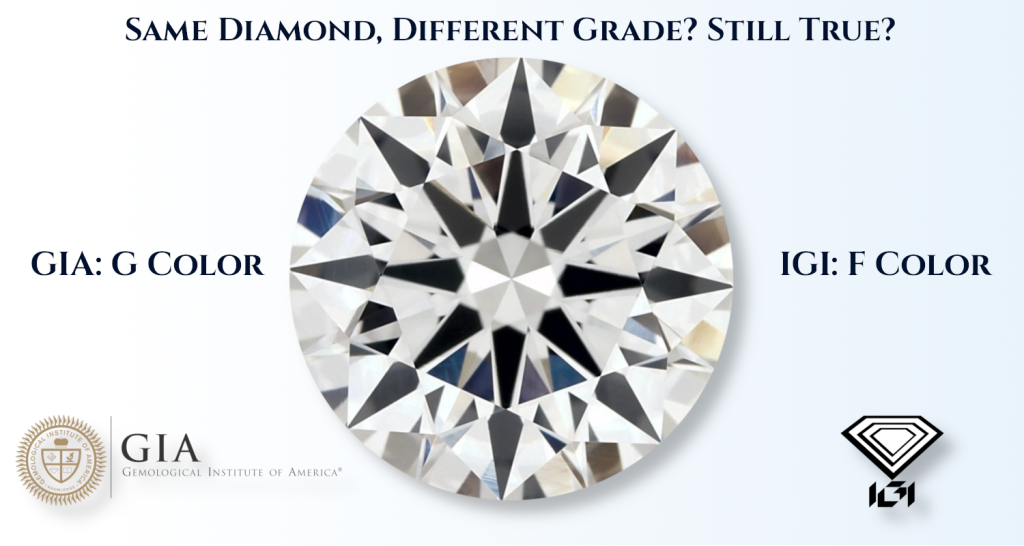
The contrast between the two labs became even sharper after GIA withdrew from full lab-grown diamond grading on October 1, 2025. Instead of issuing detailed reports with the 4Cs, GIA now gives only simplified Premium or Standard assessments. If you want the full breakdown of that decision, I have covered it in detail in my guide on GIA’s withdrawal from lab-grown diamonds.
That change left IGI in a stronger position than ever and it means buyers today would be well advised to understand the exact differences between GIA and IGI grading reports. In this article, I’ll break down how the two labs compare, where each one has the edge, which tends to be stricter in practice and how these differences affect diamond pricing. By the end, you’ll know exactly what each report really tells you about the diamond you’re buying.
Why the GIA vs IGI Debate Matters
When you are spending thousands of dollars on a diamond the grading report is the one document you rely on to tell you the truth about what you are buying. A single step in color or clarity can mean a big difference in price, especially for higher carat sizes. That is why the question of which lab is stricter and which one you can trust more is not just an academic debate, it has real financial consequences.
For decades GIA has been seen as the gold standard. Its reputation is built on consistency and global recognition. That reputation also translates directly into resale value since buyers all over the world recognize a GIA report and are willing to pay more for it. IGI on the other hand has been gaining ground quickly. Many of the top online retailers now use IGI for both natural and lab diamonds and the sheer volume of IGI reports means that for many shoppers today IGI is the grading lab they will encounter most often.
The debate matters because there are price implications. If a diamond is given a higher color or clarity grade at IGI than it would receive at GIA that could mean you are overpaying if you take the report at face value. On the flip side if IGI has truly tightened its standards, as many argue it has, then you could be getting the same quality as GIA for a better price. This is why I believe every buyer should understand the differences rather than just assuming all grading labs are the same.
In the end the grading lab is part of the value equation. Whether you are shopping for a natural diamond or a lab-grown diamond, knowing the strengths and weaknesses of GIA and IGI will help you make a smarter decision and avoid paying more than you should.
Dual-Certified Diamonds
One of the clearest ways to compare GIA and IGI directly is to look at diamonds that carry reports from both labs. These are known as dual-certified diamonds. In practice, this means the same stone has been submitted twice: once to IGI and once to GIA and each lab issued its own grade for color and clarity. Dual-certified diamonds are almost never seen in the market but when they do appear, they offer valuable insight into how GIA and IGI align or differ when grading the very same stone.
In one published analysis of dual-certified diamonds, researchers examined a small but revealing sample of roughly two dozen stones. Out of those reviewed, IGI graded stricter than GIA in some cases, looser in others and identical in the rest. The takeaway was that there isn’t a one-way bias. Sometimes IGI assigns a higher grade, sometimes GIA does and often they agree. This really challenges the old belief that IGI is always more lenient.
The following table lists the only six diamonds that can still be verified as dual-certified by checking the GIA report, which includes a note referencing the IGI inscription on the girdle. These are also the only examples for which videos are still available on James Allen. Each diamond was first graded by IGI and later by GIA. They are all natural diamonds. To make the differences clear, I’ve highlighted the two instances where color grades don’t match between labs. In the first example, GIA graded the diamond stricter, calling it a J while IGI called it an I. But in the second example, the opposite happened: IGI graded stricter, giving the diamond a G while GIA called it an F. The remaining four examples show identical grades in both color and clarity, underlining that differences between the two labs aren’t consistent in one direction:
| Carat | GIA Color | GIA Clarity | IGI Color | IGI Clarity | Link |
|---|---|---|---|---|---|
| 0.91 | J | VS2 | I | VS2 |
View Diamond
GIA: 2185231526 IGI: 229612184 |
| 0.59 | F | I1 | G | I1 |
View Diamond
GIA: 1182317325 IGI: 3806123461 |
| 1.01 | E | SI2 | E | SI2 |
View Diamond
GIA: 6137937459 IGI: 32556249 |
| 1.00 | F | SI1 | F | SI1 |
View Diamond
GIA: 7196669648 IGI: 4012131281 |
| 0.51 | D | VS2 | D | VS2 |
View Diamond
GIA: 5151343118 IGI: M2B31613 |
| 0.50 | E | VS2 | E | VS2 |
View Diamond
GIA: 2155343246 IGI: F5F87247 |
To draw any statistically meaningful conclusions, we would need hundreds of diamonds that were graded by both GIA and IGI under controlled conditions, something that has never been done. Still, it’s interesting to look at these few dual-certified stones as case studies, even if the sample size is far too small to support any firm conclusions. So far, publicly available analyses are small and anecdotal and they show mixed results rather than a consistent pattern of IGI being more lenient.
I see these dual-certification cases as a useful reminder that no lab is perfect. Both GIA and IGI are staffed by professionals using standardized methods, yet grading still involves judgment calls at the margins. The fact that results can differ between labs is precisely why buyers need to know which lab issued the report before making a final decision.
The Key Differences Between GIA and IGI Reports
While both GIA and IGI provide grading reports that cover the essential 4Cs, there are noticeable differences in how much technical detail each lab includes, especially when it comes to proportions and clarity plotting. These differences don’t necessarily make one report better, but they do influence how much insight a buyer or jeweler can gain from the paperwork alone.
Proportion Analysis: GIA Lists Two More Measurements
GIA reports list a larger number of proportions than IGI. A standard GIA proportions diagram shows 8 measurable parameters, while IGI typically lists six. The most important difference is that GIA includes the star length and lower-half length, which are not shown in IGI reports:
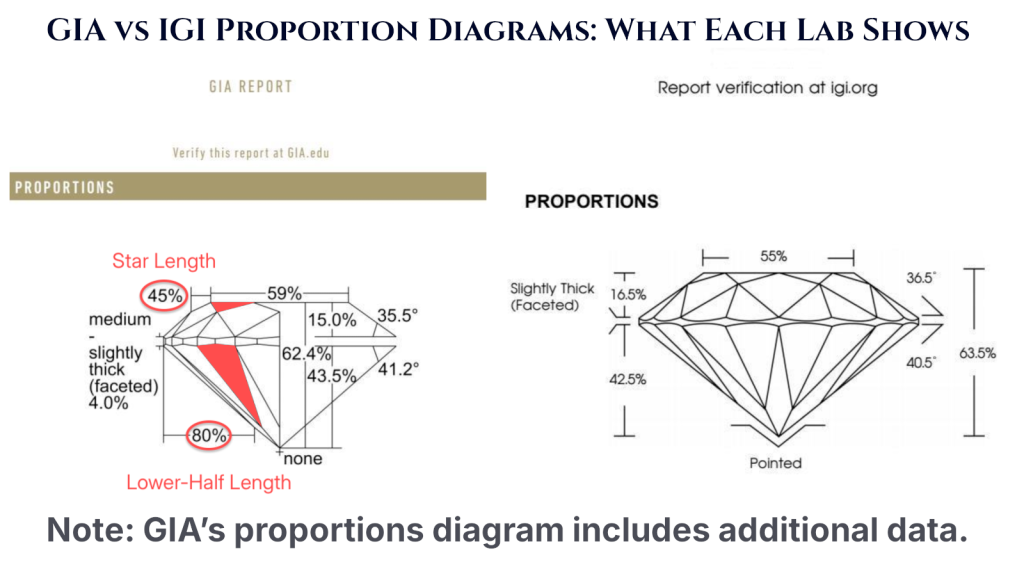
The star length describes how far the upper star facets extend from the table toward the girdle, while the lower-half length (also known as lower girdle length) measures how far the lower pavilion facets stretch from the girdle toward the culet. Together, these two values play a major role in determining how light behaves inside the diamond: they directly affect its contrast patterns, sparkle size and fire or and how lively and balanced the diamond appears.
For example, a diamond with shorter lower halves (around 70-75%) tends to show broader, chunkier flashes of light that give it more of a bold, old-school sparkle, while longer lower halves (around 80-85%) create thinner, more splintered reflections that produce a crisp, modern brilliance. While crown angle, pavilion angle and table percentage remain the three most influential proportions for light performance, lower-half length is next in line in importance. It’s a subtle yet meaningful detail that you’ll find on a GIA report but not on an IGI report.
GIA grades the lower girdle length in 5% increments and for optimal overall light performance you typically want to look for a 75% or 80% lower-half length. For instance, in the sparkle video of this 75% lower girdle Whiteflash diamond, you can see that its flashes are a little chunkier than the finer fire flashes of this 80% lower girdle diamond. If you want to understand how all of these proportions work together to create sparkle, read my complete guide on diamond proportions for a full deep dive into the topic.
If you want to see such details for yourself, Whiteflash is one of the few vendors that specializes exclusively in super ideal cut diamonds. Every diamond comes with two separate HD sparkle and brilliance videos. This way, you can observe how subtle changes in proportions, like the lower-half length we just discussed, influence light return, contrast and fire.
So for precision buyers or anyone studying a diamond’s optical symmetry, GIA’s more complete data set is clearly more useful. In short, GIA reports make it easier to understand why a diamond performs as it does, while IGI reports focus on the overall grading result rather than the technical anatomy behind it.
GIA vs IGI Cut Grade Strictness
GIA’s cut grading system is generally seen as a little stricter than IGI’s. In practical terms this means that a diamond with borderline proportions might receive an “Excellent” cut grade from IGI but only a “Very Good” from GIA. IGI’s light performance model allows slightly wider combinations of crown and pavilion angles than GIA’s cut grading system to qualify for the top grade. GIA’s system, by contrast, penalizes those edge cases more quickly.
That said, the difference between the two systems matters less than many people think. Even within GIA’s own “Excellent” range there is a lot of variation. Two diamonds can both carry the same top grade and yet look very different in real life. One may look lively and full of fire, the other flat and lacking contrast. GIA’s Excellent category includes proportion sets that can still leak light or show weaker scintillation.
The diamond shown below is graded Excellent by GIA, yet its proportions push the upper limits of what still qualifies for that grade. In this case, the pavilion angle of 41.8° is steep enough to cause light leakage through the center of the stone, a result of light rays escaping rather than reflecting back to the viewer’s eye. While GIA’s system still considers this combination acceptable for an Excellent cut, it demonstrates how diamonds near the boundary of the grade can lose contrast and brilliance, appearing glassy or dull despite carrying GIA’s highest cut designation.
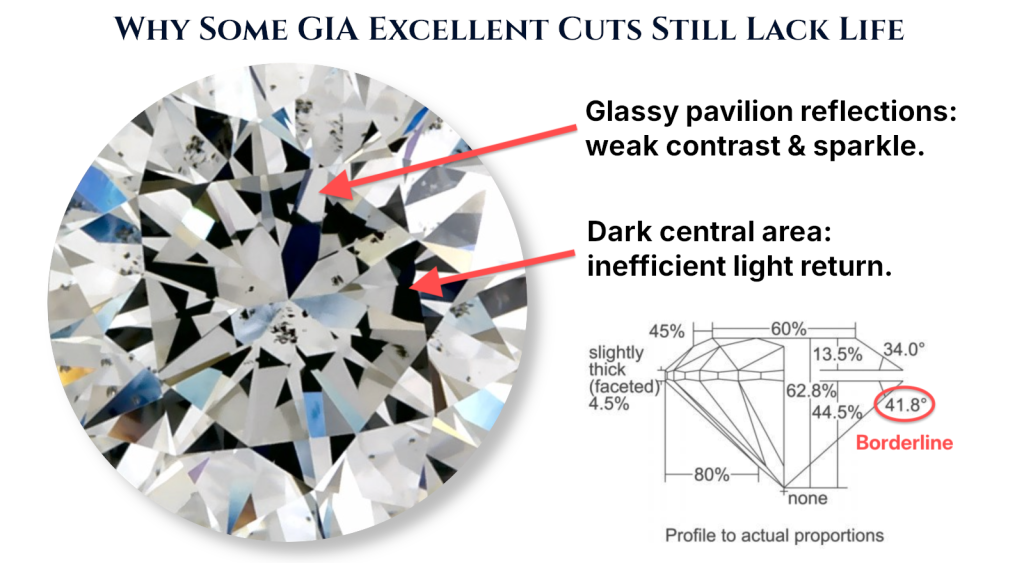
So rather than focusing on which lab is stricter on the cut grade, the real goal is to choose a diamond that falls within the most proven proportion ranges for brightness, fire and balance. These are often referred to as super ideal or Tolkowsky-style proportions.
To get as close as possible to that ideal, look for a crown angle between about 34° and 35°, a pavilion angle between 40.6° and 40.9°, and a table percentage around 55-57%. These three proportions together are the best predictors of superior light performance regardless of the cut grade and which lab graded the stone.
Clarity Plot Symbols: Less Detail in IGI Diagrams
Another subtle but meaningful difference lies in the clarity plot. GIA uses a set of standardized, published symbols to show the type and location of inclusions, such as crystals, feathers, needles or clouds. Each inclusion type is drawn with its specific shape and color code (red for internal, green for external), making it easy to understand what you’re seeing inside the diamond at a glance:
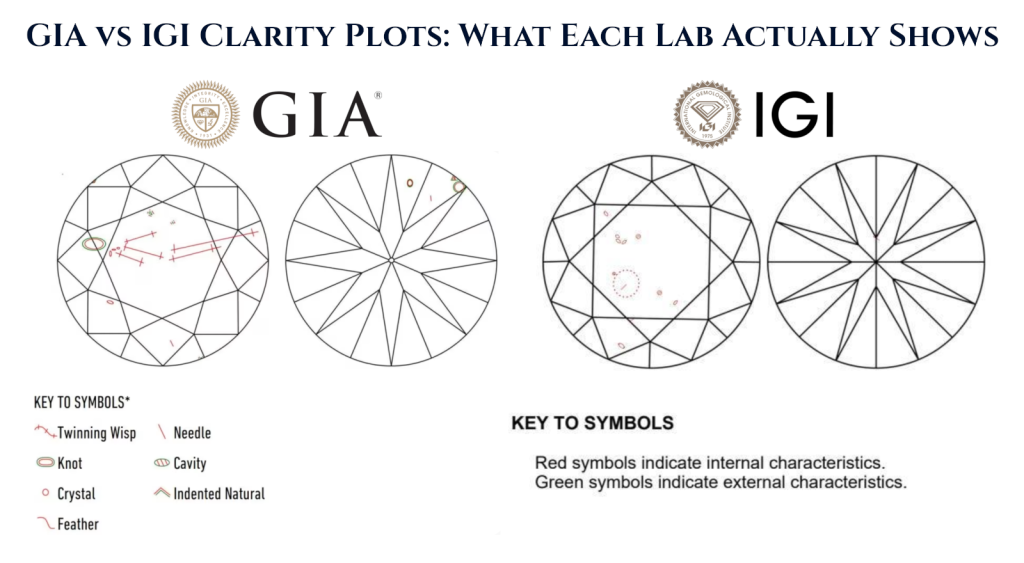
IGI, on the other hand, has no officially published set of clarity plot symbols. It’s not just that they don’t provide the key to symbols on the grading report, they don’t provide them anywhere at all! While many IGI natural diamond reports include an inclusion map, the markings are generic and lack the visual cues that identify inclusion types. And digital IGI reports, especially lab-grown ones, don’t feature a clarity plot at all!
For most retail buyers this doesn’t pose a major problem, since modern magnified imagery and video reveal the inclusions directly. However, for gemologists, appraisers and advanced buyers who want to analyze a diamond’s internal structure in detail, the lack of standardized clarity symbols makes IGI plots harder to interpret. It also means you can’t as easily compare two IGI-graded diamonds by their plots alone or verify that a particular inclusion is, for example, a feather rather than a crystal. If you want to learn more about these inclusion types and how they appear under magnification, read my complete guide on diamond inclusions.
In short, GIA’s plotting system gives professionals and enthusiasts a clearer window into what’s inside a diamond, while IGI’s simplified approach is designed more for accessibility than analytical depth.
GIA vs IGI Fancy Shape Cut Grades
One area where IGI actually goes further than GIA is in grading the cut quality of fancy-shaped diamonds (anything that isn’t round). IGI assigns cut grades to all shapes: oval, cushion, emerald, pear, marquise and others, while GIA doesn’t do that. For these shapes GIA only grades polish and symmetry, leaving buyers without an official cut grade.
This difference matters because cut quality has a huge impact on how a fancy-shaped diamond looks. Without a cut grade, GIA leaves buyers to interpret proportions and light behavior themselves, which isn’t easy unless you have experience, access to advanced imaging, or you read one of my detailed diamond shape guides. IGI’s approach offers a bit more guidance by providing a consistent “Excellent” to “Poor” cut scale across all shapes. At least that’s what you might think at first glance.
Let’s look at the oval cut diamond, since it has quickly become the second most popular diamond shape in recent years. In IGI’s chart for an Oval Excellent Cut, there’s an additional requirement that immediately stands out: “Bow tie effect is not significant.”
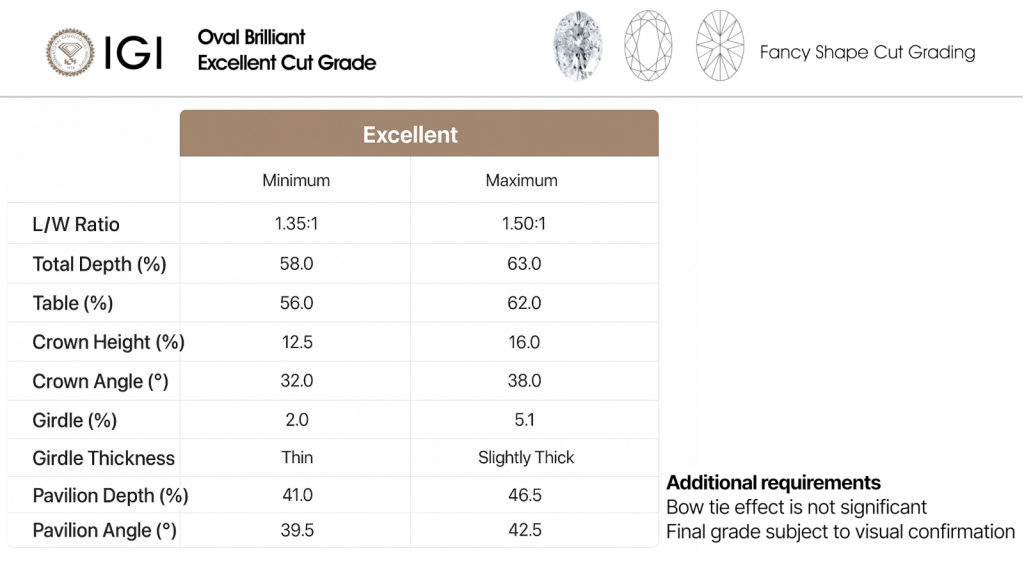
The bow tie effect is the dark shadow that stretches across the center of the diamond and it’s one of the most important issues that shows up in oval cut diamonds. And describing it as “not significant” is far too subjective. What seems subtle to one grader might be clearly visible to another and even a mild bow tie can dramatically affect how evenly the diamond sparkles and how balanced it appears face-up.
And that’s exactly why GIA avoids giving cut grades for fancy shapes altogether. Unlike round brilliants, there’s no universal formula that guarantees light performance in these designs. Even an IGI “Excellent” oval can appear dull if its depth, table or facet pattern is off.
IGI was also the first lab to certify a newer designer shape known as the Octagon cut, which is a hybrid between round and Asscher brilliance. Its eight-sided design catches light differently from any traditional shape:
See the Octagon cut diamond in motion at James Allen →
So, I do appreciate that IGI at least attempts to offer guidance with fancy-shape cut grades, even with very recent shapes like the Octagon cut diamond. But I still find the system a bit gimmicky. It’s okay that they include it, it gives buyers a reference point but I’d never rely on it alone. Fancy cuts always need to be judged visually, ideally with videos, ASET or Ideal-Scope images, before trusting any report. If you want to see exactly what ASET and Ideal-Scope images reveal, Whiteflash provides both for every diamond they sell, making it easy to judge light performance before you buy.
IGI Lists a Lab Diamond’s Growth Method
One key advantage of an IGI lab-grown diamond report is that it clearly specifies how the diamond was created, whether by CVD (Chemical Vapor Deposition) or HPHT (High Pressure High Temperature). This information appears prominently on the grading report, usually under the diamond’s description:
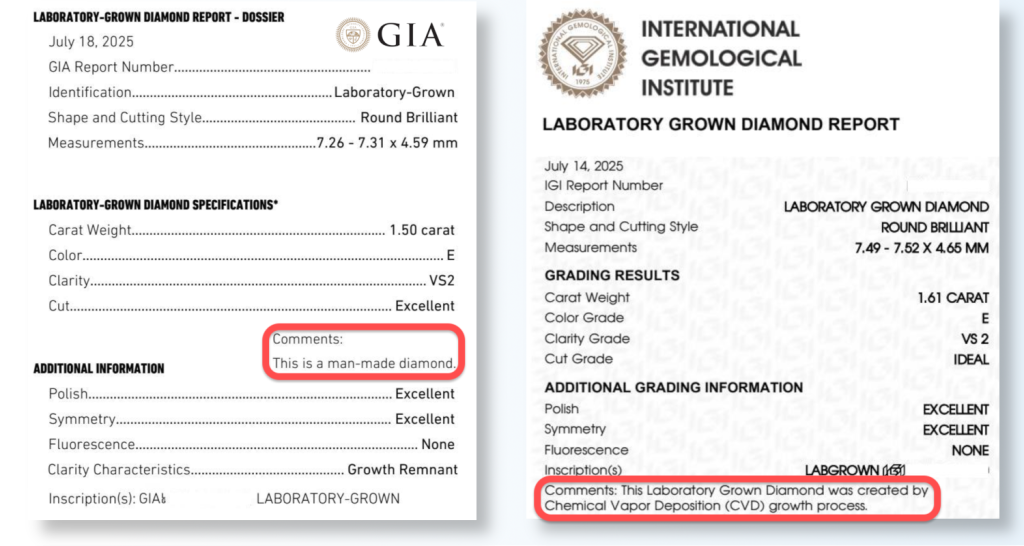
For informed buyers, this detail matters. HPHT and CVD diamonds can differ slightly in appearance, growth structure and potential strain patterns under magnification. HPHT stones are typically more likely to show blue tints or internal graining, while CVD stones can show faint striations or brownish undertones before post-growth treatment. Read my guide to lab-grown diamond color for all the details. Knowing the production method helps you understand why one diamond might appear cooler or warmer than another, even if both share identical 4Cs.
In the past, some buyers saw HPHT as the higher-quality method but that perception is gradually fading. HPHT diamonds are often praised for their color purity and stable crystal structure, since the growth conditions closely resemble those in nature. CVD, on the other hand, tends to produce diamonds with fewer metallic inclusions and allows for greater control in growing larger, cleaner stones. Early CVD diamonds sometimes had brownish tints, but modern production and post-growth treatments have largely eliminated that issue. Today, both methods can produce visually identical, top-quality diamonds when done well.
To identify whether a lab diamond was grown by HPHT or CVD, IGI uses advanced spectroscopic testing methods such as photoluminescence (PL) and Fourier-transform infrared spectroscopy (FTIR). These analyses reveal characteristic absorption patterns that distinguish the two growth processes. The equipment required is expensive and the procedure adds measurable lab time and cost, which is why GIA chose not to specify the growth method in standard reports. GIA focused on the diamond’s optical and structural properties rather than its growth origin and argued that a visually identical diamond should be graded purely by its measurable 4Cs. IGI, by contrast, positioned itself early on as a transparency-focused lab for lab-grown diamonds, giving buyers full disclosure about how their stone was created.
But as I mentioned previously, the situation has now changed so dramatically that GIA is withdrawing from lab-grown diamonds and their new so-called Lab-Grown Diamond Quality Assessment does not even specify the 4Cs anymore for lab-grown diamonds! So no more 4Cs and no origin report from GIA for lab-created diamonds. Clearly, IGI now has the total and unquestionable edge in lab-grown diamond grading!
Our Key Takeaway
Price-wise, it can make perfect sense to look for IGI-graded natural diamonds if you want to stretch your budget a little further. In my own experience, IGI can occasionally be more lenient in color grading, but hardly so in clarity. The difference isn’t drastic, yet it can translate into meaningful savings when you’re shopping within the same 4Cs range.
If you compare a series of IGI-graded H-color diamonds with no or faint fluorescence and clarity grades better than VS2 to GIA-graded H-color diamonds, you may notice something interesting: When viewed side-by-side on a large screen, GIA’s H-color stones tend to appear just a touch whiter on average. Not all of them but enough to sense a subtle pattern. H color sits right at the threshold where warmth starts to become visible to the naked eye, so that makes it the perfect range to detect small grading differences between labs. The difference is smaller than most people expect but it’s there and it’s part of what gives GIA its reputation for tighter color control.
In short:
GIA is best when you want long-term resale value, verified color precision and universal trust. IGI is ideal for buyers who prioritize price and availability, especially in the lab-grown or budget-conscious natural diamond market.
For everyday shoppers, the smartest move is to take advantage of high-resolution videos and 360° diamond views rather than relying on lab names alone.
If you want to explore real diamonds side by side and see how subtle grading differences translate in actual appearance, James Allen makes that easy with magnified, HD videos of every diamond in its inventory.
In my own browsing tests, I’ve noticed how even small grading differences become obvious once you can spin and zoom in on each diamond. That’s why I always recommend comparing several side by side before deciding. Below, I’ve answered a few of the most common questions readers ask about GIA and IGI grading, including some that might surprise you.